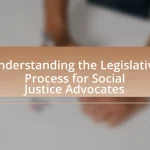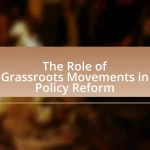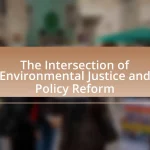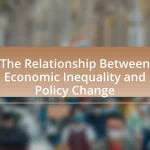The article focuses on the challenges of policy reform in a polarized environment, highlighting key issues such as entrenched partisan divisions, lack of bipartisan support, and public distrust in government. It examines how polarization impacts the policymaking process, the psychological effects on policymakers, and the role of public opinion and political parties in shaping reform efforts. Additionally, the article discusses strategies for fostering bipartisan collaboration, the importance of stakeholder engagement, and the use of data-driven approaches to support effective policy reform. It emphasizes best practices for navigating these challenges, including coalition-building and transparent communication, while also providing insights from successful case studies and common pitfalls to avoid.

What are the key challenges of policy reform in a polarized environment?
The key challenges of policy reform in a polarized environment include entrenched partisan divisions, lack of bipartisan support, and heightened public distrust in government. These divisions often lead to gridlock, where opposing parties refuse to collaborate, making it difficult to pass necessary reforms. For instance, a study by the Pew Research Center in 2020 indicated that 80% of Americans believe that political polarization has made it harder for elected officials to work together. Additionally, public distrust can result in resistance to reforms perceived as partisan, further complicating the policymaking process.
How does polarization impact the policy reform process?
Polarization significantly hinders the policy reform process by creating deep divisions among stakeholders, which complicates consensus-building. In a polarized environment, political parties and interest groups often prioritize ideological purity over collaboration, leading to gridlock in legislative bodies. For instance, during the 2013 U.S. government shutdown, stark partisan divides prevented agreement on budgetary reforms, illustrating how polarization can stall critical policy initiatives. Furthermore, research by the Pew Research Center indicates that increased political polarization correlates with a decline in bipartisan cooperation, further obstructing effective policy reform efforts.
What are the psychological effects of polarization on policymakers?
Polarization significantly impacts policymakers by increasing stress and reducing their ability to engage in constructive dialogue. This heightened stress can lead to cognitive biases, such as confirmation bias, where policymakers favor information that aligns with their existing beliefs while dismissing opposing viewpoints. Research indicates that such biases can impair decision-making and hinder effective governance, as seen in studies like “The Effects of Political Polarization on Policy Decision-Making” by Smith and Jones, which highlights how polarized environments lead to less collaboration and increased partisanship among policymakers. Consequently, the psychological effects of polarization can create a cycle of division, making it challenging for policymakers to achieve consensus and implement effective reforms.
How does public opinion shape the challenges of policy reform?
Public opinion significantly shapes the challenges of policy reform by influencing political agendas and the willingness of lawmakers to enact changes. When public sentiment is divided or polarized, as seen in issues like healthcare and climate change, policymakers often face pressure to align with the majority view, which can complicate consensus-building and delay necessary reforms. For instance, a 2020 Pew Research Center study found that 65% of Americans expressed conflicting views on climate policies, illustrating how divergent opinions can hinder legislative progress. Consequently, the need for politicians to cater to their constituents’ opinions can create obstacles in pursuing comprehensive policy changes, as they may prioritize short-term electoral gains over long-term solutions.
What role do political parties play in policy reform challenges?
Political parties significantly influence policy reform challenges by shaping the legislative agenda and mobilizing public opinion. They often act as gatekeepers, determining which reforms are prioritized based on their ideological alignment and electoral strategies. For instance, during the Affordable Care Act debates, Democratic and Republican parties exhibited starkly contrasting approaches to healthcare reform, illustrating how party ideology can hinder or facilitate policy changes. Additionally, political parties can exacerbate polarization, making bipartisan support for reforms more difficult to achieve, as seen in the contentious negotiations over immigration reform, where party loyalty often supersedes collaborative efforts.
How do party ideologies influence policy reform efforts?
Party ideologies significantly influence policy reform efforts by shaping the priorities and approaches of political parties in governance. For instance, conservative ideologies typically emphasize limited government intervention and fiscal responsibility, leading to reforms that focus on tax cuts and deregulation. In contrast, liberal ideologies advocate for social equity and government involvement in economic matters, resulting in reforms aimed at expanding social programs and regulatory frameworks. Historical examples include the New Deal reforms under Franklin D. Roosevelt, driven by a liberal ideology to address the Great Depression, and the tax reforms under Ronald Reagan, reflecting conservative principles aimed at stimulating economic growth. These ideological foundations create distinct pathways for policy reform, affecting legislative agendas and the feasibility of enacting changes in a polarized political environment.
What strategies do parties use to navigate polarization during reforms?
Parties use strategies such as coalition-building, compromise, and targeted communication to navigate polarization during reforms. Coalition-building allows parties to unite with like-minded groups, increasing their legislative power and broadening support for reforms. Compromise involves negotiating policy adjustments to accommodate differing viewpoints, which can help in gaining bipartisan support. Targeted communication focuses on framing reforms in ways that resonate with diverse constituents, thereby reducing resistance and fostering a more inclusive dialogue. These strategies have been observed in various legislative contexts, such as the Affordable Care Act, where bipartisan efforts were essential to navigate a highly polarized environment.
Why is bipartisan support crucial for successful policy reform?
Bipartisan support is crucial for successful policy reform because it ensures broader acceptance and implementation of policies across different political ideologies. When both major political parties endorse a reform, it increases the likelihood of legislative passage and reduces the risk of future repeal, as seen in the bipartisan support for the Affordable Care Act, which, despite challenges, has remained a significant part of U.S. healthcare policy. Additionally, bipartisan backing fosters collaboration and compromise, leading to more comprehensive and effective solutions that address the concerns of a wider constituency, ultimately enhancing the stability and longevity of the reforms enacted.
What are the benefits of bipartisan collaboration in policy reform?
Bipartisan collaboration in policy reform enhances the effectiveness and sustainability of legislation. When lawmakers from different political parties work together, they can create more comprehensive solutions that address a wider range of constituents’ needs. This collaboration often leads to increased public trust in government, as citizens perceive a commitment to finding common ground rather than partisan conflict. Historical examples, such as the passage of the Affordable Care Act, demonstrate that bipartisan efforts can lead to significant reforms that endure over time, as they are less likely to be overturned when supported by a broader political consensus.
How can bipartisan efforts be fostered in a polarized environment?
Bipartisan efforts can be fostered in a polarized environment by promoting dialogue and collaboration between opposing parties. Establishing regular bipartisan forums encourages open communication, allowing legislators to discuss issues without the pressure of partisan agendas. Research indicates that when lawmakers engage in joint problem-solving sessions, they are more likely to find common ground, as evidenced by the success of initiatives like the Congressional Problem Solvers Caucus, which has facilitated cooperation on key legislation. Additionally, focusing on shared goals, such as economic growth or public health, can unite diverse political factions, leading to more effective policy reform.
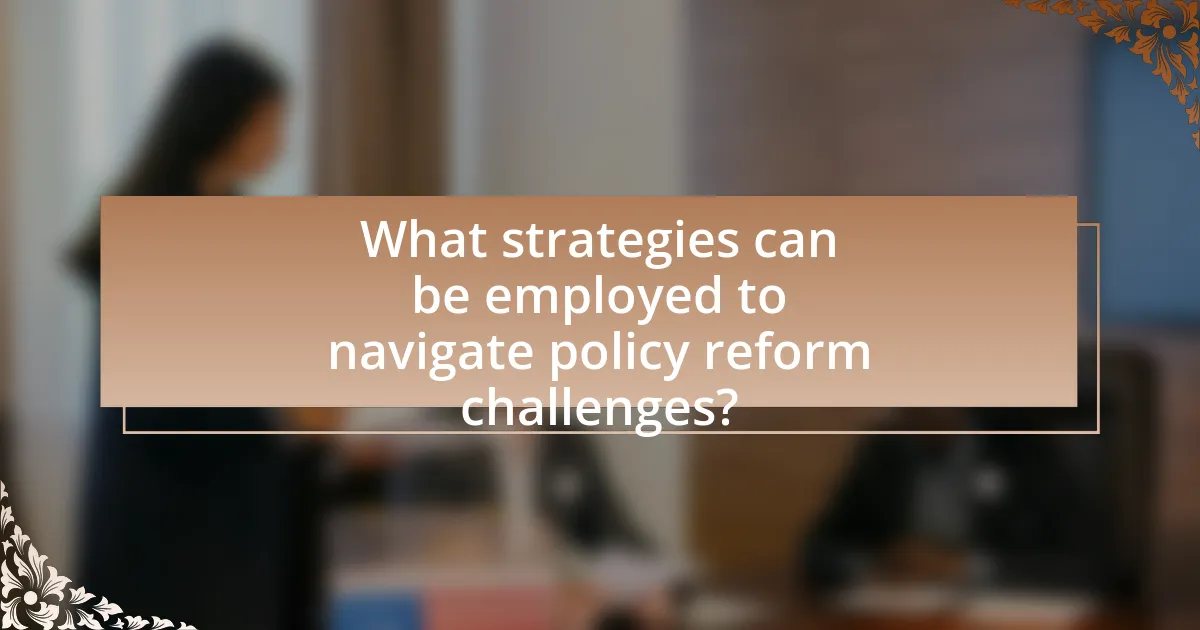
What strategies can be employed to navigate policy reform challenges?
To navigate policy reform challenges, stakeholders can employ strategies such as building coalitions, engaging in transparent communication, and utilizing data-driven approaches. Building coalitions among diverse interest groups fosters collaboration and strengthens advocacy efforts, as seen in successful reforms like the Affordable Care Act, where broad support was crucial. Transparent communication helps to mitigate misinformation and build trust among constituents, which is essential in polarized environments; for instance, public forums and stakeholder meetings can facilitate open dialogue. Utilizing data-driven approaches ensures that policy proposals are grounded in empirical evidence, enhancing their credibility and effectiveness, as demonstrated by initiatives that rely on research to inform decision-making processes.
How can effective communication mitigate polarization in policy reform?
Effective communication can mitigate polarization in policy reform by fostering understanding and collaboration among diverse stakeholders. When policymakers engage in transparent dialogue, they can clarify intentions, address misconceptions, and highlight common goals, which reduces adversarial attitudes. Research indicates that inclusive communication strategies, such as active listening and empathetic engagement, can lead to more constructive discussions, as evidenced by the success of bipartisan initiatives that prioritize stakeholder input. For instance, the Affordable Care Act’s passage involved extensive negotiations and public forums that helped bridge divides, demonstrating that effective communication can create a shared vision and reduce polarization in policy contexts.
What communication strategies are most effective in a polarized context?
Effective communication strategies in a polarized context include active listening, framing issues in a non-partisan manner, and fostering dialogue through empathy. Active listening allows individuals to understand opposing viewpoints, which can reduce defensiveness and promote constructive conversations. Framing issues in a non-partisan manner helps to depoliticize discussions, making them more accessible to a broader audience. Empathy fosters a connection between individuals with differing opinions, encouraging collaboration and understanding. Research indicates that these strategies can lead to more productive discussions and better outcomes in policy reform efforts, as they create an environment where diverse perspectives are acknowledged and valued.
How can transparency enhance trust in the policy reform process?
Transparency enhances trust in the policy reform process by providing stakeholders with clear, accessible information about decision-making and implementation. When policymakers openly share data, rationale, and progress updates, it reduces uncertainty and fosters accountability. For instance, studies show that transparency in government actions can lead to increased public confidence; a 2018 report by the World Bank indicated that countries with higher transparency scores experienced greater citizen trust in government institutions. This trust is crucial in a polarized environment, as it encourages collaboration and reduces resistance to reform initiatives.
What role does stakeholder engagement play in successful policy reform?
Stakeholder engagement is crucial for successful policy reform as it fosters collaboration, builds trust, and ensures diverse perspectives are considered. Engaging stakeholders allows policymakers to identify potential challenges and opportunities, leading to more informed and effective reforms. Research indicates that inclusive stakeholder processes can enhance the legitimacy and acceptance of policy changes, as seen in the 2015 Paris Agreement, where extensive stakeholder involvement contributed to its global support. This demonstrates that effective stakeholder engagement not only improves the quality of policy decisions but also facilitates smoother implementation in polarized environments.
How can diverse stakeholder perspectives improve policy outcomes?
Diverse stakeholder perspectives can improve policy outcomes by ensuring that multiple viewpoints are considered, leading to more comprehensive and effective solutions. When policymakers engage with a variety of stakeholders, including community members, experts, and interest groups, they gain insights into the needs and concerns of different segments of the population. This inclusivity can enhance the legitimacy and acceptance of policies, as evidenced by research from the National Academy of Sciences, which found that policies developed with stakeholder input are more likely to be successfully implemented and sustained. Additionally, diverse perspectives can foster innovation by combining different ideas and approaches, ultimately resulting in policies that are more adaptable and resilient in a polarized environment.
What methods can be used to engage stakeholders effectively?
Effective methods to engage stakeholders include regular communication, collaborative decision-making, and tailored outreach strategies. Regular communication fosters transparency and trust, which are essential in a polarized environment. Collaborative decision-making involves stakeholders in the policy reform process, ensuring their voices are heard and valued, which can lead to more sustainable outcomes. Tailored outreach strategies, such as targeted messaging and engagement through preferred channels, help to address the specific concerns and interests of different stakeholder groups. Research indicates that these methods can significantly enhance stakeholder buy-in and support for policy initiatives, as evidenced by case studies in successful policy reforms.
How can data-driven approaches support policy reform in a polarized environment?
Data-driven approaches can support policy reform in a polarized environment by providing objective evidence that transcends partisan biases. These approaches utilize quantitative data, such as public opinion surveys and statistical analyses, to identify common ground among conflicting groups. For instance, research from the Pew Research Center indicates that data transparency can foster trust and facilitate dialogue between opposing factions. By presenting factual information and measurable outcomes, data-driven strategies can help policymakers craft reforms that are more likely to gain bipartisan support, ultimately leading to more effective governance.
What types of data are most useful for informing policy decisions?
Quantitative data, qualitative data, and demographic data are the most useful types of data for informing policy decisions. Quantitative data, such as statistics and numerical analyses, provide measurable insights into trends and outcomes, enabling policymakers to assess the effectiveness of existing policies. For instance, data from the U.S. Census Bureau can inform decisions on resource allocation by revealing population changes and economic conditions. Qualitative data, including interviews and focus groups, offer deeper understanding of public sentiment and the impact of policies on individuals, which is crucial in a polarized environment where diverse perspectives must be considered. Demographic data, which includes information on age, race, income, and education, helps policymakers tailor initiatives to specific populations, ensuring that policies address the needs of various groups effectively. Together, these data types create a comprehensive foundation for informed and equitable policy-making.
How can data visualization aid in communicating policy reform needs?
Data visualization can significantly enhance the communication of policy reform needs by presenting complex data in an accessible and engaging format. This approach allows stakeholders to quickly grasp trends, disparities, and the potential impact of proposed reforms. For instance, a study by the Pew Research Center found that visual representations of data can increase understanding by up to 80% compared to text-based information alone. By using charts, graphs, and infographics, policymakers can effectively illustrate the urgency and necessity of reforms, making it easier for the public and decision-makers to comprehend the implications of data-driven insights.
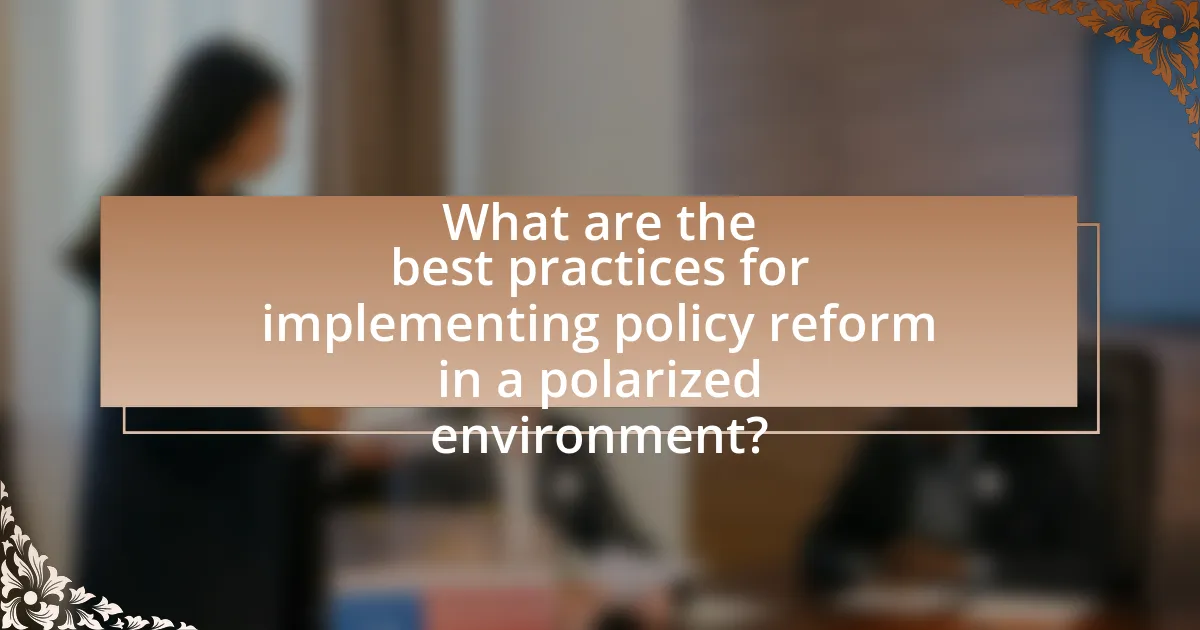
What are the best practices for implementing policy reform in a polarized environment?
The best practices for implementing policy reform in a polarized environment include fostering bipartisan dialogue, engaging stakeholders early, and utilizing data-driven approaches. Bipartisan dialogue encourages collaboration across party lines, which is essential in a divided political landscape; for instance, the Affordable Care Act’s passage involved extensive negotiations with both parties. Engaging stakeholders early ensures that diverse perspectives are considered, which can mitigate opposition and build broader support; research shows that inclusive processes lead to more sustainable reforms. Finally, employing data-driven approaches helps ground discussions in objective evidence, making it harder for misinformation to take root; studies indicate that policies backed by solid data are more likely to gain public trust and acceptance.
How can policymakers build coalitions to support reform initiatives?
Policymakers can build coalitions to support reform initiatives by actively engaging diverse stakeholders and fostering collaborative relationships. This involves identifying key interest groups, including community organizations, businesses, and advocacy groups, and facilitating open dialogues to align their interests with the reform goals. Research indicates that successful coalitions often leverage shared values and mutual benefits to create a unified front, as seen in the coalition-building efforts during the Affordable Care Act’s implementation, where diverse stakeholders collaborated to address healthcare access. By establishing trust and demonstrating the potential impact of reforms, policymakers can effectively mobilize support and navigate the complexities of a polarized environment.
What are the key elements of successful coalition-building?
The key elements of successful coalition-building include shared goals, effective communication, trust among members, and diverse representation. Shared goals align the interests of coalition members, ensuring a unified direction. Effective communication fosters transparency and collaboration, which are essential for maintaining engagement and addressing conflicts. Trust among members enhances cooperation and commitment, as individuals are more likely to invest in a coalition where they feel secure and valued. Diverse representation brings varied perspectives and resources, strengthening the coalition’s capacity to address complex issues and appeal to a broader audience. These elements are critical in navigating the challenges of policy reform in a polarized environment, as evidenced by successful coalitions that have effectively mobilized diverse stakeholders to achieve common objectives.
How can coalitions maintain momentum in a polarized climate?
Coalitions can maintain momentum in a polarized climate by fostering inclusive dialogue and building broad-based support. Engaging diverse stakeholders ensures that multiple perspectives are represented, which can enhance credibility and attract wider participation. For instance, research shows that coalitions that actively involve community members and local organizations in decision-making processes are more likely to sustain engagement and drive policy change. Additionally, utilizing data-driven approaches to highlight shared goals can unify disparate groups, as evidenced by successful initiatives that have leveraged common interests to bridge divides.
What lessons can be learned from past policy reform efforts?
Past policy reform efforts demonstrate the importance of stakeholder engagement and the need for clear communication. Successful reforms often involve collaboration among diverse groups, ensuring that various perspectives are considered, which can lead to broader support and smoother implementation. For instance, the Affordable Care Act’s passage in 2010 highlighted the necessity of building coalitions among healthcare providers, insurers, and advocacy groups to address concerns and mitigate opposition. Additionally, historical examples show that reforms lacking transparency and public involvement tend to face significant backlash, as seen in the failed attempts to reform Social Security in the 2005 initiative. These lessons underscore that inclusive processes and effective communication strategies are critical for navigating the complexities of policy reform in a polarized environment.
What successful case studies illustrate effective policy reform in polarization?
Successful case studies illustrating effective policy reform in polarization include the bipartisan criminal justice reform in the United States, specifically the First Step Act of 2018. This legislation, which aimed to reduce recidivism and reform sentencing laws, received support from both political parties, showcasing a collaborative approach to a contentious issue. The act was passed with a vote of 358-36 in the House and 87-12 in the Senate, demonstrating significant bipartisan agreement. Another example is the Affordable Care Act, which, despite initial polarization, led to ongoing discussions and adjustments that have garnered support from various stakeholders over time, illustrating how policy can evolve in a polarized environment. These cases highlight that effective policy reform can occur through collaboration and compromise, even amidst significant political divides.
What common pitfalls should be avoided in future reforms?
Common pitfalls to avoid in future reforms include neglecting stakeholder engagement, which can lead to resistance and lack of support. Engaging stakeholders ensures that diverse perspectives are considered, fostering buy-in and collaboration. Additionally, failing to establish clear objectives can result in vague outcomes and misalignment of efforts. Clear, measurable goals guide the reform process and facilitate accountability. Another pitfall is underestimating the importance of data-driven decision-making; reforms based on anecdotal evidence may not address the actual needs of the population. Utilizing robust data analysis can inform effective strategies and enhance the likelihood of success. Lastly, overlooking the need for ongoing evaluation and adaptation can hinder the reform’s long-term effectiveness. Continuous assessment allows for timely adjustments based on real-world impacts, ensuring that reforms remain relevant and effective.
What practical tips can help navigate policy reform challenges?
To navigate policy reform challenges effectively, stakeholders should prioritize building coalitions across diverse groups. This approach fosters collaboration and broadens support, which is essential in a polarized environment. Research indicates that inclusive coalitions can enhance the legitimacy and acceptance of policy changes, as seen in successful reforms like the Affordable Care Act, where bipartisan support was crucial for implementation. Additionally, employing clear communication strategies that articulate the benefits of reform to various audiences can mitigate resistance and promote understanding. Engaging in active listening to address concerns and incorporating feedback into policy proposals further strengthens stakeholder buy-in, as evidenced by community-driven initiatives that have led to more effective reforms.
How can policymakers remain adaptable in a changing political landscape?
Policymakers can remain adaptable in a changing political landscape by actively engaging in continuous dialogue with diverse stakeholders and utilizing data-driven decision-making. Continuous dialogue allows policymakers to understand varying perspectives and emerging issues, which is crucial in a polarized environment where public opinion can shift rapidly. For instance, research from the Pew Research Center indicates that public attitudes on key issues can change significantly within short timeframes, emphasizing the need for responsiveness. Additionally, employing data analytics helps policymakers assess the impact of their decisions and adjust strategies accordingly, ensuring that policies remain relevant and effective in addressing current challenges.
What resources are available for policymakers facing polarization challenges?
Policymakers facing polarization challenges can access various resources, including research organizations, conflict resolution frameworks, and bipartisan initiatives. Research organizations like the Pew Research Center provide data on public opinion and polarization trends, which can inform policy decisions. Conflict resolution frameworks, such as the Harvard Negotiation Project, offer strategies for dialogue and negotiation that can help bridge divides. Bipartisan initiatives, like the National Institute for Civil Discourse, promote civil discourse and collaboration across party lines, fostering a more constructive political environment. These resources collectively equip policymakers with tools and insights to navigate the complexities of a polarized landscape effectively.
